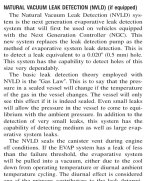"Sealed" was too strong a word. You can fault me for oversimplifying to keep my post less verbose.Peva,
"But for me, it explained in particular why lawnmowers and other smaller engine devices don't tolerate aged ethanol fuel, whereas old ethanol fuel doesn't seem to bother running/starting quality of car"
Free water in fuel is rare, if sourced from a reputable supplier with a high turnover, keeping the fuel fresh. No engine, new or old, likes water in the fuel.
Older engines (fuel systems) even in cars, may not tolerate E in fuel - this is because the system may have components that the E will damage. O rings, hoses, floats, valves, etc are often damaged by E.
Any petrol powered engine (rated to use E blend) will run just fine on ethanol blend. High usage (regular refresh) is the best. Low usage, especially when tank below 75% full, for extended periods, is more likly to result in condensation (water) contaminating the fuel.
"....systems of automobiles are required to be sealed...."
ALL fuel tanks "breathe" atmospheric air - to my understanding no conventional fuel tanks are sealed. True they may have a higher degree of "sealing" than say a mower. If truly sealed. they would collapse as the fuel was used and or atmospheric pressure/temperature changes impacted on them. All air contains more/less water vapour that will condense on relativly cool surfaces. Metal fuel tanks are more prone to condensation than plastic.
(Putting on my tap shoes...)
Car systems allow a controlled pressure relief, and of course, as you suggest, allow air to enter to displace the freed up tank volume as fuel is used. The evaporative emissions system limits (controls) free exchange with the atmosphere in regards to the vapor pressure of the fuel.
That is different than having the tank essentially open to the atmosphere as it would be with a non-sealing gas cap (or passive breather hole in the top of the tank). With the ignition off, the various evaporative emission system valves communicating to the atmosphere are of the "normally closed" type (no free exchange of gaseous substances), so the system at that point is essentially sealed to the atmosphere. When the system is active (ignition on), vapors are ported to the engine plenum (downstream of the throttle body) thru a vacuum hose connection.


